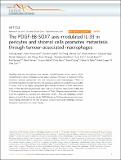The PDGF-BB-SOX7 axis-modulated IL-33 in pericytes and stromal cells promotes metastasis through tumour-associated macrophages
Author(s)
Yang, Yunlong; Andersson, Patrik; Hosaka, Kayoko; Zhang, Yin; Cao, Renhai; Iwamoto, Hideki; Yang, Xiaojuan; Nakamura, Masaki; Wang, Jian; Zhuang, Rujie; Morikawa, Hiromasa; Braun, Harald; Beyaert, Rudi; Samani, Nilesh; Nakae, Susumu; Hams, Emily; Dissing, Steen; Fallon, Padraic G.; Cao, Yihai; Xue, Yuan; Langer, Robert S; ... Show more Show less
DownloadThe PDGF-BB-SOX7.pdf (3.652Mb)
PUBLISHER_CC
Publisher with Creative Commons License
Creative Commons Attribution
Terms of use
Metadata
Show full item recordAbstract
Signalling molecules and pathways that mediate crosstalk between various tumour cellular compartments in cancer metastasis remain largely unknown. We report a mechanism of the interaction between perivascular cells and tumour-associated macrophages (TAMs) in promoting metastasis through the IL-33–ST2-dependent pathway in xenograft mouse models of cancer. IL-33 is the highest upregulated gene through activation of SOX7 transcription factor in PDGF-BB-stimulated pericytes. Gain- and loss-of-function experiments validate that IL-33 promotes metastasis through recruitment of TAMs. Pharmacological inhibition of the IL-33–ST2 signalling by a soluble ST2 significantly inhibits TAMs and metastasis. Genetic deletion of host IL-33 in mice also blocks PDGF-BB-induced TAM recruitment and metastasis. These findings shed light on the role of tumour stroma in promoting metastasis and have therapeutic implications for cancer therapy.
Date issued
2016-05Department
Massachusetts Institute of Technology. Institute for Medical Engineering & Science; Massachusetts Institute of Technology. Department of Biological Engineering; Massachusetts Institute of Technology. Department of Chemical EngineeringJournal
Nature Communications
Publisher
Nature Publishing Group
Citation
Yang, Yunlong et al. “The PDGF-BB-SOX7 Axis-Modulated IL-33 in Pericytes and Stromal Cells Promotes Metastasis through Tumour-Associated Macrophages.” Nature Communications 7 (2016): 11385.
Version: Final published version
ISSN
2041-1723